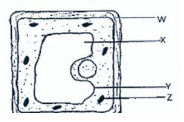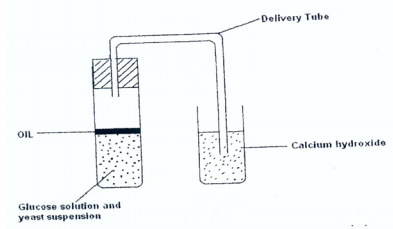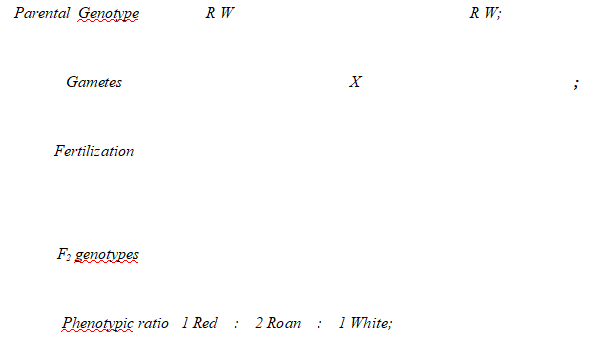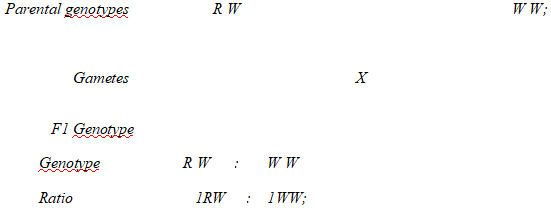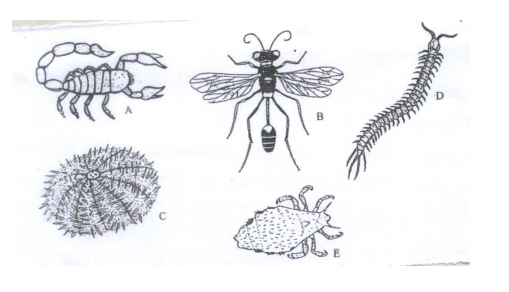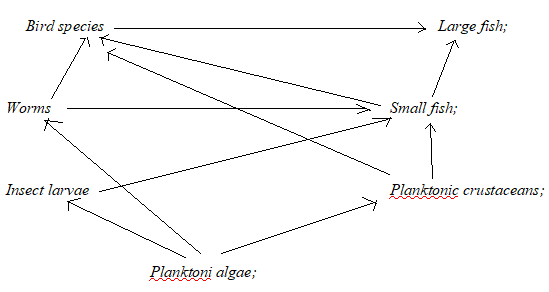SECTION A (40 MARKS)
Answer all the questions in this section.
- Examine the diagram below carefully and use it to answer the questions that follow.
- Name the parts X, Y and Z.(3 marks)
X: Sap vacuole;
Y: Tonoplast
Z: Chloroplast
- State the main substance which make-up the part labeled W. (1 mark)
Cellulose
- Name the process through which mineral salts move into the structure labeled X. (1 mark)
Active transport; /Diffusion
- Explain what happens to a red blood cell when placed in distilled water. (3 marks)
The cell sap is hypertonic to the distilled water; Water molecules move into the cell by osmosis; making the cell to swell and eventually burst;
- Name the parts X, Y and Z.(3 marks)
- What is meant by natural selection? (4 marks)
Organisms with suitable variations in a population survives in a competition for resources; those with unsuitable variations die out; Through the process suitable genes are passed on to offspring’s; while unsuitable genes are eliminated from the population;
- State four sources of evidences that support the theory of organic evolution. (4 marks)
-Fossil records/ Paleontology;
-Comparative anatomy;
-Comparative embryology;
-Geographical distribution;
-Cell biology;
-Serology;
- What is meant by natural selection? (4 marks)
- The diagram below shows a set up that was used to demonstrate a certain physiological process.
The glucose solution was boiled and oil added on top of it. The glucose solution was then allowed to cool before adding yeast suspension.- Identify the physiological process that was being investigated using the above set up. (1 mark)
Fermentation / Alcoholic fermentation / Anaerobic respiration;
- Why was glucose boiled during the experiment? (1 mark)
Drive off dissolved oxygen/air from the glucose solution.
- What was the importance of cooling the glucose before adding the yeast suspension? (1 mark)
To avoid denaturing the enzymes in yeast cell / destroy zymase enzymes;
- What observation would be made in test tube at the end of the experiment? (1 mark)
Calcium hydroxide forms a white precipitate;
- How would the observation made in (d) above be affected if oil was not added on top of the yeast suspension during the experiment? (1 mark)
Calcium hydroxide remains colourless;
- In another investigation, a bird was found to use 10 litres of oxygen to give a respiratory quotient of 0.7 during period of flight. Name the type of food that was being respired by the bird and determine the amount of carbon (IV) oxide produced during the same flight.
Type of food :- (1 mark)Lipid / fat or Oil;
Volume of carbon (IV) oxide produced. (2 marks)
- Identify the physiological process that was being investigated using the above set up. (1 mark)
- Pure breed of red cows and pure breed of white bulls were crossed to give F1 calves which had a mixture of red and white coat known as roan. The F1 were selfed.
- Using letter R to represent gene for red colour and W to represent gene for white colour work out the phenotypic ratio of F2. (4 marks)
- Work out the genotypic ratio of a cross between F1 offspring and white bull. (3 mks)
- Comment on the gene(s) controlling the colour of coats in cattle mentioned above. (1mk)
Gene for red colour coat and white colour coat are codominant/ have equal dominance;
- Using letter R to represent gene for red colour and W to represent gene for white colour work out the phenotypic ratio of F2. (4 marks)
- You are provided with photographs of animals. Study the photographs and the dichotomous key below to enable you identify the taxonomic group to which each animal belongs.
KEY- Jointed legs present ……………………………………………………………go to 2
- Jointed legs absent………………………………………………………………..go to 7
- Three pairs of legs …………………………………………………………..go to 3
- More than 3 pairs of legs……………………………………………………….go to 5
- Wings present ……………………………………………………………….go to 4
- Wings absent…………………………………………………………………Anoplura
- One pair of wings……………………………………………………………Diptera
- Two pairs of wings………………………………………………………Hymenoptera
- Four pairs of legs ………………………………………………………… Arachnida
- More than ten pairs of legs …………………………………………………. go to 6
- One pair of legs in each body segment…………………………………… Chilopoda
- Two pairs of legs in each body segment ………………………………… Diplopoda
- Body partially enclosed in a shell………………………………………… Mollusca
- Body surface has spiny projection……………………………………….Echinodermata
- Using the key, identify the following organisms to their taxonomic groups. In each case, give the sequence of steps which you followed in identifying them. (4 marks)
Animal Identity Steps followed A Arachnida
B Hymenoptera
D Chilopoda
E Anoplura
- Using observable features only, state the class to which the animal labeled A and B on the photographs above belong (2 marks)
A - Arachnida
B - Insecta;
State two observable features on B, that enabled you to arrive at that answer in (b (i) above.(2mks)Has three pairs of legs
Has three body parts
SECTION B (40 MARKS)
Answer question six (6) in the spaces provided (compulsory). Choose either question 7 or 8 and answer in the space provided after question 8.
- Using observable features only, state the class to which the animal labeled A and B on the photographs above belong (2 marks)
- Using the key, identify the following organisms to their taxonomic groups. In each case, give the sequence of steps which you followed in identifying them. (4 marks)
- During an ecological study of a lake, a group of students recorded the following observations.
- Planktonic crustaceans feed on planktonic algae;
- Small fish feed on planktonic crustaceans, worms and insect larvae;
- Worms feed on insect larvae;
- A bird species feeds on small fish, planktonic crustaceans, worms and large fish;
- Insect larvae feed on planktonic algae;
- Large fish feed on small fish.
- From this record of observations, construct a food web. (4 marks)
- From the food web, isolate and write down a food chain that ends with:-
- Bird species as a secondary consumer. (1 mark)
Planktonic algae --------> Planktonic crustaceans -----------> Bird species;
- Large fish as a tertiary consumer. (1 mark)
Planktonic algae --------> Planktonic crustaceans --------> Small fish -----------> Large fish;
Planktonic algae ---------> Insect larvae ------------> Small fish ---------> Large fish;
- Bird species as a secondary consumer. (1 mark)
- The biomass of the producers in the lake was found to be greater than that of primary consumers. Explain this observation. (2 marks)
Energy is lost as it passes from the producers up the trophic levels; Producers require greater biomass to compensate for the energy losses in order to support consumers depending on it;
- Using the food web, identify three pairs of organisms that compete for food in the lake and for each case, name the food being competed for. (6 marks)
-Bird species and small fish; compete for planktonic crustaceans;
-Bird species and small fish; compete for worms;
-Bird species and large fish; compete for small fish;
-Planktonic crustaceans and insect larvae; compete for planktonic algae; - State three ways by which human beings may interfere with this lake ecosystem. (3 marks)
-Pollution of water;
-Overfishing;
-Introduction of new fish species into the lake;
-Biological control of mosquitoes; - Explain how each of the ways stated in (e) (i) above may affect life in the lake. (3 marks)
-Pollution caused by toxic chemical substances may kill organisms in the lake;
-Overfishing depletes some species of fish inceasing the numbers of another species of organism;
-Newly introduced fish may clear the other species or increase competition in the lake;
-Biological control of mosquitoes may lead to clearance of insect larvae which is food to other organisms;
- State three ways by which human beings may interfere with this lake ecosystem. (3 marks)
- From this record of observations, construct a food web. (4 marks)
- Describe the digestion of a starchy meal along the human alimentary canal. (13 marks)
Starch in food is first broken down in the mouth by action of teeth/ chewing; This increases the surface area exposed enzyme action; saliva contains salivary amylase which breaks down some starch to maltose; saliva has a slightly alkaline pH which is optimum for the enzyme; The food moves down to the oespophagus and stomach; where the acidic pH, due presence of dilute Hcl, prevents further action of salivary amylase; In the duodenum, pancreatic amylase continues digestion of starch to maltose; Pancreatic amylase is produced in the pancrease; and enters the duodenum through pancreatic ducts; the acidic chyme is neutralized by the sodium bicarbonate in bile/ pancreatic juice; Maltose digestion continues in the ileum; whose walls secrete succus entericus/ intestinal juice; which contains enzyme maltase; which breaks down maltose to glucose;
- Describe the process of urea formation.(7 marks)
Urea is soluble in water. It is how nitrogen is excreted by the body. The body is unable to store excess protein. Therefore, after digestion by the stomach and small intestine, the amino acids which are protein's endproducts enter the bloodstream. Excess amino acids are converted in the liver to other products by the process of deamination. The nitrogen in the amino acid becomes converted to ammonia, and this is further converted by the liver into urea, which is less toxic than ammonia to the body. The kidneys will then filter out the urea from the circulation, send it to the bladder along with water and excrete it in the form of urine.
- Describe the digestion of a starchy meal along the human alimentary canal. (13 marks)
- Describe how gaseous exchange occurs in terrestrial plants. (13 marks)
Gaseous exchange takes place in a spongy mesophyl
During the day air diffuses into large air spaces of spongy mesophyll; through stomata; the Carbon (IV) Oxide in the air diffuses into Photosynthetic cells; in solution form; during photosynthesis Carbon (iv) Oxide is used while oxygen is produced. Oxygen diffuses out of the leaf; through stomata;
During the night; air diffuses into the air spaces (of spongy mesophyll), the air dissolves into film of moisture; then oxygen diffuses into the cells; and is used in respiration during which carbon (iv) oxide is produced, the Carbon (iv) Oxide diffuses out of the leaf; through stomata; due to concentration/diffusion gradient;
Gaseous exchange takes place through epidermis (of young leaves and stems); epidermis of the root carries out gaseous exchange with air in the soil; some plants have pneumatophores/breathing roots; in which gaseous exchange occurs through lenticels; (found in older stems) - Describe the process of metamorphosis in a grasshopper. (7 marks)
Grasshoppers undergo incomplete metamorphosis The first stage of incomplete metamorphisis is the egg. During this time, the grasshopper will hatch into a form called a nymph. The nymph is basically a small version of the adult insect. Nymphs usually have a thin exoskeleton and no wings. They eat the same food as the adults and live in the same place. As insect nymphs grow larger, their exoskeleton becomes too tight and they must replace it. Once a nymph outgrows its exoskeleton it will go through a process called molting, in which it leaves the old “skin” or exoskeleton behind. The new “skin” will harden and become the new exoskeleton. This will happen many times until the grasshopper finally becomes the size of an adult.
- Describe how gaseous exchange occurs in terrestrial plants. (13 marks)
Download MOKASA Joint Evaluation Examination Biology Paper 2 2016- Pre MOCK with answers.
Tap Here to Download for 50/-
Get on WhatsApp for 50/-
Why download?
- ✔ To read offline at any time.
- ✔ To Print at your convenience
- ✔ Share Easily with Friends / Students

